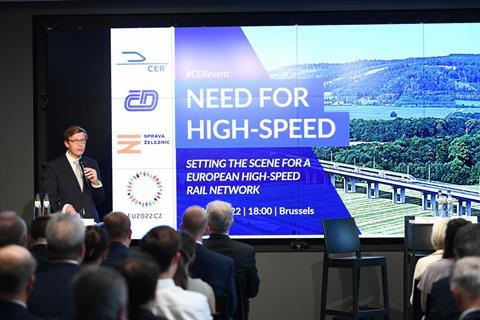
EUROPE: High speed rail investment should place greater focus on the benefits of releasing capacity on existing lines, a group of Czech policymakers and industry leaders told a summit in Brussels on July 11.
Entitled ‘The Need for High Speed’, the event was organised by the Community of European Railways & Infrastructure Companies in partnership with České Dráhy and Správa Železnic to mark the start of the Czech Republic’s six-month presidency of the EU Council; it sought to set the scene for the creation of a pan-European high speed network.
Czech infrastructure manager Správa Železnic is currently developing plans for a new line between Praha and Dresden to relieve congestion on the existing cross-border route, together with three other high speed lines which would cut journey times between the country’s principal cities.
Via Vindobona
Transport Minister Martin Kupka told attendees that this investment would place the Czech Republic at the heart of a more coherent and extensive European high speed network. ‘High speed rail represents the future of European travel. That is why the development of high speed lines by revising the TEN-T regulation is one of our main transport priorities during the Czech presidency. We must overcome “national high speed islands” and build a truly pan-European network of high speed connections.’
Kupka cited ongoing development work on the Via Vindobona proposal to accelerate services in the Berlin – Praha – Wien corridor as ‘the most important connection’. Among other interventions, a joint declaration was signed in March 2020 for the construction of a 30 km base tunnel under the Erzgebirge on the German-Czech border.
A saturated network
SŽ Director-General Jiří Svoboda commented that while the country’s high speed plans were ‘challenging’, they would not be ‘impossible to deliver, because we have never had as much political backing as we have now’. Nevertheless, he admitted that the Czech proposals for a 650 route-km network radiating across the country had ’a lot of support but also a lot of opposition’, like similar programmes elsewhere in Europe. He urged policymakers to do more ‘to convince regions, cities and people’ to back such long-term green investments.
Svoboda explained that a key element in the business case for the proposed new lines was the urgent need to release capacity on the country’s existing network, especially for freight. ‘At present we can barely accommodate any freight on our network during daylight hours — it all has to move at night.’ This, he felt, was a serious impediment to efforts to boost rail’s share of the freight market in line with the objectives of the European Green Deal.
The focus on freeing up capacity on existing tracks was warmly welcomed by Kristian Schmidt, Director of Land Transport at the European Commission’s DG Move, who suggested that not enough had historically been made of these benefits in the business cases for other new lines. ‘I’m delighted to see a link between high speed passenger rail and growing freight; we don’t talk enough about this’, he commented.
However, when asked if the Commission would be developing a specific legislative package to develop a pan-European high speed network, Schmidt insisted that ‘the tools are already there’ in the TEN-T plans, the Connecting Europe Facility and the Resilience & Recovery Fund, of which rail has been a major beneficiary.
Rail ‘too costly’
Schmidt warned that ‘rail remains too costly’ for too many Europeans, citing a statistic that 75% of Erasmus students fly to their placements rather than travelling by train. ‘We at the Commission cannot do much more, given how much support we are providing for infrastructure development. We won’t subsidise rail pricing. The member states and industry have to step up now.’
Michal Krapinec, Chief Executive of operator České Dráhy, cautioned that development of a high speed network should not just be viewed as an investment in infrastructure, because operators could also face steep costs for suitable rolling stock. ‘A fleet of 30 high speed trains could require a total procurement expenditure of €900m, which is not an insignificant sum of money’, he pointed out. Nevertheless, he argued that high speed services should be run commercially ‘with no need for a Public Service Obligation subsidy’, given that airlines on routes such as Berlin – Wien do not need support.
Concluding the discussion, CER Executive Director Alberto Mazzola urged the wider rail sector to back proposals for 10% of the revenues from the next iteration of the EU Emissions Trading Scheme to be allocated to the funding of sustainable transport infrastructure, primarily railways. ‘It is crucial that we secure political support for this very strong idea’ which he felt could offset some of the cost pressures arising from factors such as inflation and a greater focus on defence spending across member states.

















